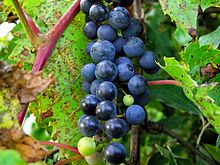 At our place along the Manitowoc River, my grandfather planted wild grapes and other plants for the birds. Later, I remember him complaining that the grapes were taking over the lilacs and cedar trees nearby. And still after that I remember the incredibly potent juice he made from the wild grapes, amply sweetened with honey. Like many things in life, wild grapes have distinct up-and-down sides.
At our place along the Manitowoc River, my grandfather planted wild grapes and other plants for the birds. Later, I remember him complaining that the grapes were taking over the lilacs and cedar trees nearby. And still after that I remember the incredibly potent juice he made from the wild grapes, amply sweetened with honey. Like many things in life, wild grapes have distinct up-and-down sides.
A few days ago, I was walking one of the trails and noticed good numbers of robins and cedar waxwings darting among the trees. I was in an area where there were few of the most typical berry-producing shrubs- dogwood and the like. But there were grapes, and Virginia creeper, and it became obvious that those were the food sources the birds were after. In some places the grapes hung in great bunches, but of course the fruits are tiny compared to their domestic cousins.
There are several species of wild grape (Vitis sp.) found in Wisconsin. The most common is Vitis riparia or riverbank grape, which is found throughout the State. It wears typical three-lobed grape leaves, and can bear masses of quarter-inch purple grapes that are more seed than flesh. Even after a frost, which is when the concord grapes we grew at home became their sweetest, these wild grapes still retain a mighty strength of sour character. I remember grandpa collecting many, many pounds that yielded precious few quarts of juice. Some of which was further processed into wine, but that’s another story.
A word of caution- there is another plant, Canada moonseed, which resembles wild grape and is poisonous. Unlike grapes, moonseed does not have tendrils with which to grasp supporting branches, and it’s fruit has a single seed. Grapes have from two to six in each fruit. Perhaps worse yet is porcelain berry, a non-native and invasive plant brought here by people- please don’t plant that one!
Birds and many mammals (perhaps even foxes) relish the sour fruit, and of course in doing so spread the seeds to grape-virgin soil. The birds include waxwings and thrushes, woodpeckers, finches, even warblers in the fall. The energy these native fruits provide helps the birds make their way to their winter homes to the south, and are more beneficial than the fruits of non-native plants, some of which are toxic.
Grapes are easy to grow if you don’t mind their aggressive habits. They will cover fences and arbors with thick foliage, turning them into living bird feeders. Do they damage trees- they absolutely can. They can weaken trees and shrubs by blocking sunlight if they cover the canopy, and the extra weight of vines can break branches, especially when loaded with ice or snow. So despite their great benefit to wildlife, one is certainly justified in trimming them away from favorite trees or decorative shrubs. But if there’s a wild corner in the yard, as there is in mine, it might just be a place for a wild grape to grow in its wild and wooly way, to the delight of the cardinals and white-throated sparrows that visit.
